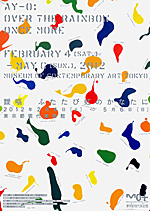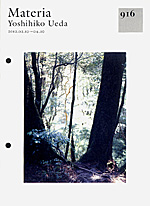 |
Picks is a monthly sampling of Japan's art scene, offering short reviews of exhibitions at museums and galleries in recent weeks, with an emphasis on contemporary art by young artists. |
 |
 |
|
|
 |
 |
 |
 |
Ay-O: Over the Rainbow Once More
|
| 4 February - 6 May 2012 |
Museum of Contemporary Art Tokyo
(Tokyo) |
 |
| Japan-born Ay-O (1931-) moved to New York in the fifties, joined the Fluxus movement, produced happenings, and created the installations known as environments. The rainbow, his trademark motif, has graced paintings, prints, installations, and a 300-meter banner flying from the Eiffel Tower. Viewing this retrospective, one can't help but see Ay-O as a venerable fixture in the contemporary art pantheon, not the youthful mischief-maker of yesteryear. |
|
 |
|

|
 |
 |
 |
|
Yoshihiko Ueda: Materia |
| 10 February - 10 April 2012 |
Gallery 916
(Tokyo) |
 |
| Photographer Ueda has opened a 600-square-meter gallery in Tokyo's dockside warehouse district. The inaugural exhibition consists of 20 large new prints by Ueda, hung at distant intervals on the stark walls of this cavernous space. The "Materia" images, of trees in the rain forests of Yakushima (an island south of Kyushu), were taken shortly after the March 11, 2011 earthquake, but they represent a continuation of his series from the early 1990s of shots of a similar rain forest on the west coast of the United States, later published in his book Quinault. |
|
|
 |
 |
|
The History of Towers |
|
|
Edo-Tokyo Museum
(Tokyo) |
 |
| The Tower of Babel, the Eiffel Tower, Asakusa's Ryounkaku, Osaka's Tsutenkaku, Tokyo Tower . . . Dramatically titled "The Tower" in Japanese, this exhibition nonetheless seems to be lacking something. For dramatic poignance or sheer height, the destroyed World Trade Center and Dubai's Burj Khalifa come to mind. But, that's right, they aren't really towers. The point of the show, of course, is to introduce and contextualize the world's (currently) tallest tower, Tokyo Sky Tree, scheduled to open to the public in May. |
|
|
|
|
|
|
|

|
 |
 |
|
 |
|
|
| Shimon Minamikawa: Mirror, Music, Multimedia |
|
17 February - 1 April 2012
|
NADiff Gallery
(Tokyo) |
 |
| A chair, table, and bicycle are scattered around the gallery; on the wall are pictures by the artist, posters, a mirror. For some reason there is also a bottle rack, homage perhaps to the famous readymade by Marcel Duchamp. Initially it looks like any other disorganized mess, but then it becomes apparent that Minamikawa put a lot of thought into the layout. It is, in fact, a surprisingly comfortable space to hang out in. |
|

|
 |
|
|
 |
|